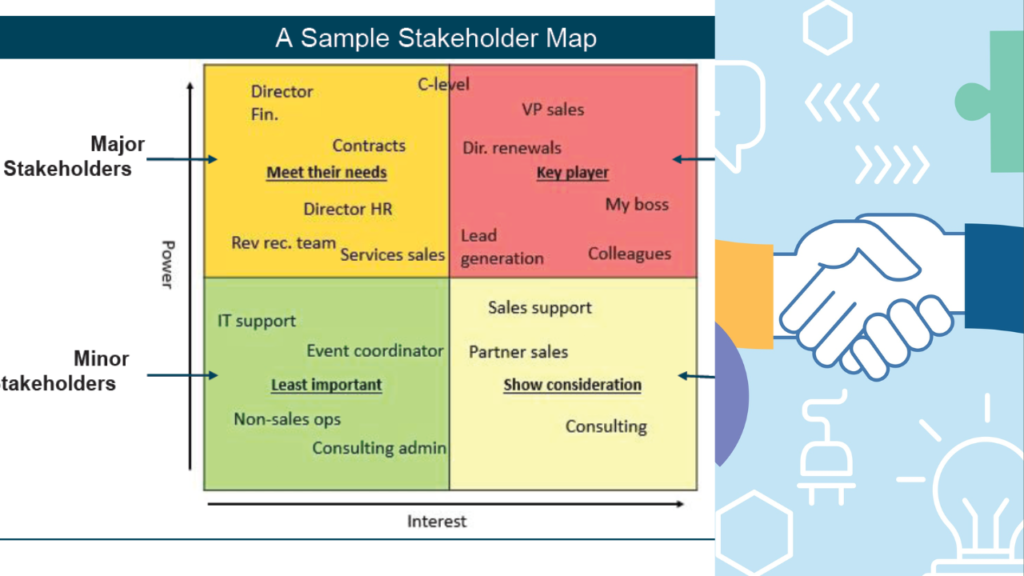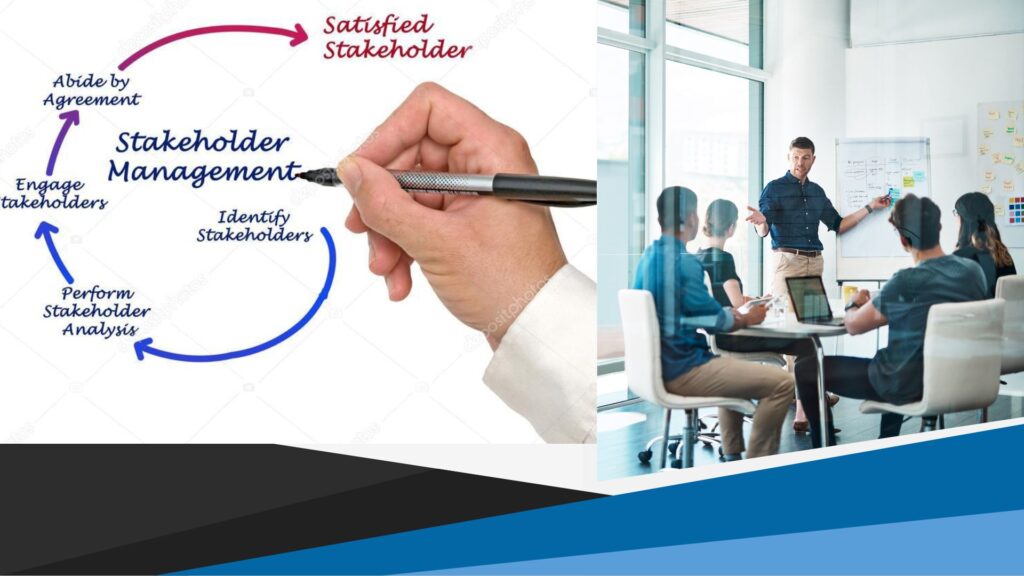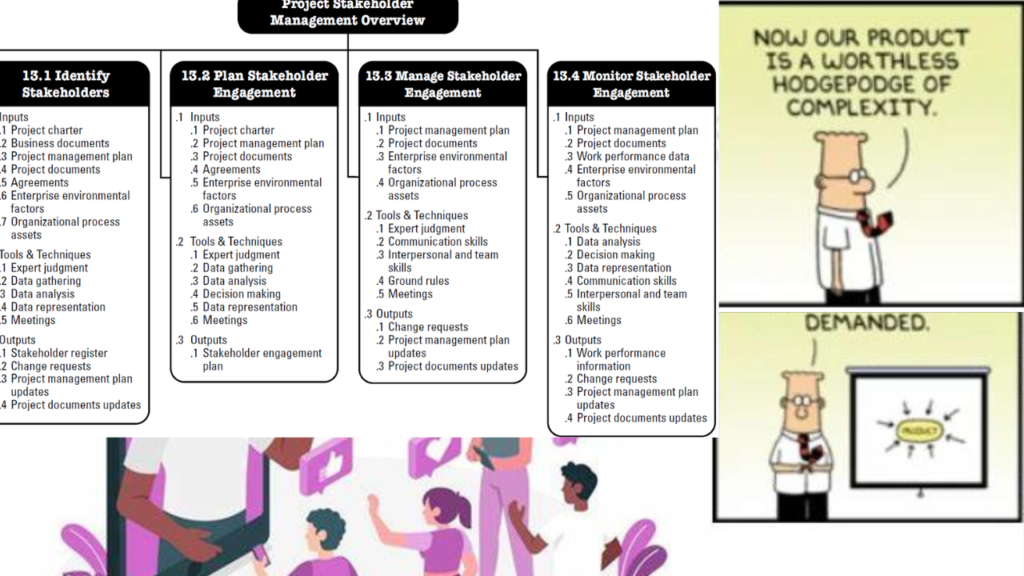The Role of Effective Stakeholder Management- “Drive viral success with strategic stakeholder management. Engage stakeholders continuously and unleash their potential for project triumph. Build strong relationships and navigate the viral project landscape with expert tips.
Table of Contents
I. Introduction
Effective project stakeholder management is a critical aspect of successful project execution. It involves identifying, analyzing, and engaging with individuals or groups who have a vested interest in the project’s outcomes. By understanding and addressing stakeholders’ needs, expectations, and concerns, project managers can build positive relationships and gain support throughout the project lifecycle.
A. Definition of Project Stakeholder Management
Project stakeholder management refers to the systematic process of identifying, analyzing, and engaging with individuals or entities that have a direct or indirect impact on a project. These stakeholders can include project sponsors, team members, customers, end-users, suppliers, regulatory authorities, and more. The primary goal of stakeholder management is to ensure that their expectations are met, potential conflicts are resolved, and their interests align with the project objectives.
- Stakeholder management is a strategic approach to identify and engage individuals or entities that can impact or be impacted by a project’s objectives.
- It involves understanding stakeholder expectations, interests, and influence levels to effectively manage their involvement.
Example: In a construction project, stakeholders may include the client, architects, contractors, local authorities, and neighboring communities.

B. Importance of Effective Stakeholder Management in Projects
Effective stakeholder management is crucial for project success. When stakeholders are actively engaged and their concerns are addressed, they are more likely to support the project, provide necessary resources, and advocate for its success. Engaged stakeholders also enhance communication and collaboration, leading to better decision-making and reduced risks of project failure.
- Effective stakeholder management fosters stakeholder engagement, leading to increased support, commitment, and cooperation.
- Engaged stakeholders can contribute valuable insights and resources, improving decision-making and project outcomes.
Example: In a software development project, involving end-users in the early stages helps gather feedback and ensures the final product meets their requirements.

C. Objectives and Scope of the Blog
In this blog, we will explore the key strategies and best practices for successful project stakeholder management. We will delve into the process of identifying stakeholders, analyzing their interests and expectations, and developing tailored engagement strategies. Additionally, the blog will discuss the significance of maintaining open communication channels, managing stakeholder expectations, and mitigating potential risks. Whether you are a project manager or a team member, this blog aims to equip you with the knowledge and tools to effectively manage stakeholders and ensure project success.
Example: A project manager successfully navigates stakeholder relationships to secure funding, resources, and timely approvals for a complex infrastructure project.
II. Identifying Project Stakeholders
Identifying project stakeholders is the foundational step in effective stakeholder management. Understanding the concept of stakeholders, categorizing them appropriately, and employing suitable techniques for identification are essential for successful project execution.
A. Understanding the Concept of Stakeholders
- Stakeholders are individuals, groups, or organizations that can influence or be influenced by the project’s objectives, activities, or outcomes.
- They may have direct or indirect interests in the project and can impact its success or face consequences from its results.
Example: In a new product development project, stakeholders may include customers, product managers, marketing teams, suppliers, and regulatory authorities.
B. Key Stakeholder Categories: Internal, External, Primary, Secondary
- Internal Stakeholders: These are individuals within the organization directly involved in the project, such as project managers, team members, and executives.
Example: In a marketing campaign project, the internal stakeholders may include the marketing team, creative designers, and the marketing director.
- External Stakeholders: External stakeholders are entities outside the organization that have an interest in the project’s outcomes, such as customers, vendors, and government agencies.
Example: For a construction project, external stakeholders could include nearby residents, environmental agencies, and local authorities.
- Primary Stakeholders: Primary stakeholders have a significant and direct interest in the project, as they are directly affected by its success or failure.
Example: In a community development project, primary stakeholders could be the residents of the community who will benefit from the project’s improvements.
- Secondary Stakeholders: Secondary stakeholders have an indirect or lesser interest in the project, and their influence may not be as significant as primary stakeholders.
Example: In an IT system implementation project, secondary stakeholders may include IT support staff who are not directly involved but may be impacted by the changes.

C. Techniques for Stakeholder Identification
- Stakeholder Interviews: Conducting one-on-one interviews with relevant individuals to understand their perspectives and involvement in the project.
Example: A project manager interviews key department heads to identify internal stakeholders and gather their expectations.
- Surveys and Questionnaires: Distributing surveys or questionnaires to a broader group of potential stakeholders to gather their insights and preferences.
Example: An organization sends out a survey to customers to identify their preferences and expectations for a new product development project.
- Stakeholder Mapping: Creating visual representations of stakeholders’ relationships and interests to understand their roles and potential impact.
Example: A project team uses a stakeholder map to identify key stakeholders and their connections in a public infrastructure project.
By comprehensively understanding stakeholders, categorizing them appropriately, and employing effective identification techniques, project managers can set the stage for successful stakeholder management, paving the way for smoother project execution and positive project outcomes.
III. Analyzing Stakeholder Interests and Expectations
Analyzing stakeholder interests and expectations is a crucial step in project stakeholder management. By conducting a thorough stakeholder analysis, project managers can gain valuable insights into stakeholders’ needs, concerns, and levels of influence. This information enables them to tailor communication and engagement strategies, fostering positive relationships and ensuring project success.
A. Conducting Stakeholder Analysis
- Stakeholder analysis involves systematically gathering and assessing information about each stakeholder’s characteristics, interests, and potential impact on the project.
- It helps project managers understand the dynamics among stakeholders and identify potential areas of support or conflict.
Example: In an environmental conservation project, stakeholder analysis may involve understanding the interests and concerns of local communities, environmental organizations, government agencies, and investors.
B. Identifying Stakeholder Needs and Expectations
- Identifying stakeholders’ needs and expectations involves actively engaging with them to understand their requirements and desired project outcomes.
- This process ensures that the project aligns with stakeholder expectations and contributes to meeting their specific needs.
Example: For a software development project, engaging with end-users through focus groups and surveys helps identify their functional and usability expectations.
C. Prioritizing Stakeholder Influence and Impact
- Prioritizing stakeholders based on their influence and impact helps project managers allocate resources and efforts more effectively.
- High-influence stakeholders may require more attention and involvement, while low-influence stakeholders may need periodic updates.
Example: In a construction project, the city planning department may have high influence due to regulatory approvals, while nearby businesses may have a lower impact on the project’s overall success.
By conducting comprehensive stakeholder analysis, project managers can gain a deep understanding of stakeholders’ interests and expectations. This analysis serves as a foundation for developing tailored engagement strategies, addressing potential concerns, and building strong relationships. Prioritizing stakeholders based on their influence and impact allows project managers to focus their efforts where they will have the most significant positive impact, ultimately leading to better project outcomes and stakeholder satisfaction.
IV. Developing Stakeholder Engagement Strategies
Developing effective stakeholder engagement strategies is essential for maintaining positive relationships and ensuring successful project outcomes. Tailoring communication plans, addressing stakeholder concerns, and resolving conflicts are critical components of stakeholder engagement.
A. Creating a Communication Plan
- A communication plan outlines how project information will be shared with stakeholders, including the frequency, channels, and key messages.
- It ensures that stakeholders receive timely and relevant updates, fostering transparency and trust.
Example: A communication plan for a new product launch project may include regular email updates, bi-weekly status meetings, and a dedicated project website for stakeholders to access information.
B. Tailoring Engagement Strategies for Different Stakeholder Groups
- Different stakeholders have varying interests, preferences, and levels of involvement. Tailoring engagement strategies for each group ensures their specific needs are met.
- This approach demonstrates that the project team values and respects stakeholders’ perspectives.
Example: In an education reform project, engagement strategies may involve workshops and consultations with teachers, parents, students, and educational administrators, catering to each group’s unique requirements.
C. Addressing Stakeholder Concerns and Resolving Conflicts
- Proactively addressing stakeholder concerns and conflicts is vital for maintaining a positive project environment.
- Active listening and prompt resolution of issues demonstrate responsiveness and commitment to stakeholder satisfaction.
Example: In a construction project, if neighboring residents express concerns about noise pollution, the project team may implement noise reduction measures and establish a community feedback mechanism to address their grievances.
By creating a comprehensive communication plan, tailoring engagement strategies, and promptly addressing stakeholder concerns and conflicts, project managers can foster constructive relationships with stakeholders. Engaged stakeholders are more likely to offer support, collaborate effectively, and advocate for the project’s success. Successful stakeholder engagement is a continuous process that requires ongoing communication, adaptability, and a genuine commitment to meeting stakeholder needs throughout the project lifecycle.
V. Maintaining Effective Communication
Effective communication is the backbone of successful stakeholder management. Maintaining open and transparent communication with stakeholders ensures clarity, fosters trust, and enables project managers to address concerns promptly. Utilizing various communication channels and platforms, along with monitoring and measuring communication effectiveness, enhances stakeholder engagement and project outcomes.
A. Importance of Communication in Stakeholder Management
- Communication plays a pivotal role in stakeholder management by keeping stakeholders informed, engaged, and supportive of the project.
- Transparent communication builds trust and enables stakeholders to make informed decisions, reducing the likelihood of misunderstandings and conflicts.
Example: In a healthcare project, clear communication with patients, medical staff, and administrators ensures everyone is aware of the project’s objectives, timelines, and potential impacts on patient care.
B. Utilizing Various Communication Channels and Platforms
- Employing a mix of communication channels and platforms allows project managers to reach different stakeholder groups effectively.
- Different stakeholders may prefer emails, meetings, newsletters, social media, or dedicated project portals for receiving updates.
Example: A technology company uses a combination of team meetings, instant messaging apps, and a project management software tool to ensure seamless communication among remote team members and stakeholders.
C. Monitoring and Measuring Communication Effectiveness
- Monitoring and measuring communication effectiveness help project managers assess whether stakeholders are receiving and understanding the information shared.
- Regular feedback and evaluation enable adjustments to be made to communication strategies for improved engagement.
Example: After launching a new website, an e-commerce company tracks user engagement metrics and customer feedback to evaluate the effectiveness of their communication about the site’s features and benefits.
Maintaining effective communication throughout the project lifecycle ensures stakeholders are well-informed, engaged, and supportive of project objectives. It empowers project managers to address concerns proactively, resolve issues promptly, and maintain a positive project environment. By using diverse communication channels and platforms and continuously monitoring communication effectiveness, project managers can build strong relationships with stakeholders, foster collaboration, and increase the likelihood of project success. Clear and transparent communication is the key to nurturing a project’s stakeholders and ensuring a harmonious and productive project journey.
VI. Managing Stakeholder Expectations
Effectively managing stakeholder expectations is vital for project success. It involves setting realistic project expectations, handling scope creep and changing requirements, and gaining stakeholder buy-in and support.
A. Setting Realistic Project Expectations
- Setting clear and realistic project expectations from the outset is crucial for avoiding misunderstandings and dissatisfaction later on.
- Realistic expectations help stakeholders understand project constraints and align their objectives with achievable outcomes.
Example: In a software development project, project managers collaborate with stakeholders to define project scope, timelines, and deliverables, ensuring expectations are in line with available resources.
B. Dealing with Scope Creep and Changing Requirements
- Scope creep refers to the gradual expansion of project scope beyond its original boundaries, leading to additional work and potential delays.
- Handling changing requirements requires flexibility and effective change management to accommodate evolving stakeholder needs.
Example: In a marketing campaign project, stakeholders may request additional features or target audience adjustments. Project managers assess the impact of these changes on the project timeline and resources before incorporating them.
C. Gaining Stakeholder Buy-In and Support
- Gaining stakeholder buy-in involves obtaining their agreement and support for the project’s objectives and proposed strategies.
- Engaging stakeholders in decision-making and addressing their concerns fosters a sense of ownership and commitment.
Example: In an infrastructure development project, engaging with local communities and obtaining their input on the project design can lead to greater buy-in and support from the affected residents.
By setting realistic project expectations, effectively managing scope creep and changing requirements, and gaining stakeholder buy-in and support, project managers can create a positive environment for collaboration and achieve project objectives. Managing stakeholder expectations requires open communication, adaptability, and proactive engagement with stakeholders throughout the project lifecycle. When stakeholders have a clear understanding of what to expect and feel their voices are heard, they are more likely to be actively invested in the project’s success and contribute to its favorable outcomes.
VII. Anticipating and Mitigating Risks
Anticipating and mitigating risks related to stakeholder management is essential to ensure smooth project execution and stakeholder satisfaction. By identifying potential risks, developing contingency plans, and implementing proactive measures, project managers can navigate challenges effectively and minimize negative impacts on the project.
A. Identifying Potential Risks Related to Stakeholder Management
- Identifying potential risks related to stakeholder management involves assessing factors that may adversely affect stakeholder engagement and project success.
- Risks may include stakeholder resistance, conflicting interests, lack of support, or miscommunication.
Example: In a large-scale construction project, a potential risk could be local community protests due to perceived environmental concerns.
B. Developing Contingency Plans for Managing Risks
- Developing contingency plans involves outlining alternative approaches to address identified risks if they occur during the project.
- Contingency plans provide a roadmap for handling unforeseen circumstances and ensuring the project stays on track.
Example: To address stakeholder resistance in a change management project, a contingency plan may include additional communication efforts, engaging stakeholders in problem-solving workshops, and adjusting project timelines.
C. Proactive Measures to Minimize Negative Impact
- Implementing proactive measures involves taking preventive actions to minimize the likelihood and impact of potential risks.
- Building strong stakeholder relationships, regular communication, and addressing concerns promptly are proactive strategies.
Example: In a software development project, proactive measures may include conducting user feedback sessions to address end-users’ needs early on and reducing the risk of dissatisfaction.
By proactively identifying risks, developing contingency plans, and implementing measures to minimize negative impacts, project managers can enhance stakeholder satisfaction and project success. Anticipating and managing risks related to stakeholder management demonstrates project preparedness and a commitment to handling challenges effectively. Stakeholder satisfaction and collaboration are crucial for successful project outcomes, and proactive risk management contributes to fostering a positive project environment and maintaining stakeholder support throughout the project lifecycle.
VIII. Assessing Stakeholder Satisfaction
Assessing stakeholder satisfaction is a critical aspect of effective project stakeholder management. It involves collecting feedback, evaluating stakeholder satisfaction, and using surveys and feedback mechanisms to continuously improve the project based on stakeholders’ input.
A. Collecting Feedback and Evaluating Stakeholder Satisfaction
- Collecting feedback from stakeholders allows project managers to gain insights into their level of satisfaction with project progress and outcomes.
- Evaluating stakeholder satisfaction helps identify areas of improvement and ensure project alignment with stakeholder expectations.
Example: In a customer service improvement project, project managers conduct regular feedback sessions with customers to assess their satisfaction with the service quality.
B. Using Surveys and Feedback Mechanisms
- Surveys and feedback mechanisms provide structured ways to gather stakeholder opinions and perceptions.
- They offer anonymity, encouraging stakeholders to provide honest feedback, which can be crucial for identifying improvement areas.
Example: An online survey is used to collect feedback from employees on their satisfaction with a company’s new work-life balance initiatives.
C. Incorporating Stakeholder Feedback into Project Improvement
- Incorporating stakeholder feedback into project improvement involves actively using the collected insights to make necessary adjustments and enhancements.
- It demonstrates responsiveness to stakeholder needs and a commitment to continuous improvement.
Example: In an e-learning platform development project, feedback from students and instructors is used to enhance the platform’s usability and content relevance.
By actively collecting and evaluating stakeholder feedback and using surveys and feedback mechanisms, project managers can maintain a pulse on stakeholder satisfaction. Incorporating stakeholder feedback into project improvement is essential for fine-tuning project activities and outcomes to better align with stakeholder expectations. Continuous improvement based on stakeholder input fosters trust, strengthens relationships, and ensures the project remains responsive to changing stakeholder needs and preferences. Ultimately, a satisfied and engaged stakeholder community contributes significantly to the overall success and positive impact of the project.
IX. Adapting Stakeholder Management for Agile Projects
Stakeholder management in agile projects requires a dynamic and iterative approach to accommodate the fast-paced nature of agile methodologies. Tailoring stakeholder management, continuous engagement, and balancing flexibility with meeting stakeholder expectations are essential for success in agile environments.
A. Tailoring Stakeholder Management for Agile Methodologies
- Stakeholder management in agile projects involves adapting traditional practices to suit the agile principles of collaboration and flexibility.
- Emphasizing transparency, open communication, and stakeholder involvement throughout the project lifecycle is crucial.
Example: In an agile software development project, stakeholders actively participate in sprint planning meetings and have access to the project’s backlog and progress metrics.
B. Continuous Stakeholder Engagement and Iterative Feedback
- Agile projects prioritize continuous stakeholder engagement to maintain alignment with evolving requirements and project goals.
- Frequent iterations and feedback loops allow stakeholders to provide input and influence the project’s direction.
Example: In an agile marketing campaign, stakeholders participate in regular review meetings where campaign performance data is shared, and feedback is sought for future iterations.
C. Balancing Flexibility and Meeting Stakeholder Expectations
- Balancing flexibility with meeting stakeholder expectations is a delicate act in agile projects.
- Project managers must be responsive to changing stakeholder needs while ensuring that project objectives and quality standards are not compromised.
Example: In an agile product development project, the product owner collaborates closely with stakeholders to prioritize features, ensuring the most valuable ones are delivered first while still meeting deadlines.
By tailoring stakeholder management for agile methodologies, emphasizing continuous engagement and iterative feedback, and striking a balance between flexibility and meeting stakeholder expectations, project managers can harness the full potential of agile practices. In agile environments, stakeholders are more involved in decision-making, fostering a sense of ownership and collaboration. The iterative nature of agile allows project teams to remain responsive to stakeholder needs, resulting in a product or service that better aligns with customer expectations and market demands. Adapting stakeholder management for agile projects empowers teams to deliver value and achieve project success in the rapidly changing business landscape.
X. Case Studies: Successful Project Stakeholder Management
In this section, we will explore real-life examples of projects that exemplify effective stakeholder management. These case studies highlight the importance of stakeholder engagement, communication, and proactive measures in achieving project success. Additionally, we will draw valuable lessons and best practices from these case studies to apply in our own stakeholder management endeavors.
A. Real-Life Examples of Effective Stakeholder Management
- Project: Green City InitiativeDescription: A city’s sustainable development project aimed at reducing carbon emissions and enhancing green spaces.Stakeholder Management Approach:
- Engaged with local residents, environmental groups, and businesses through town hall meetings and focus groups.
- Incorporated stakeholder feedback into the project design and implementation, leading to greater community buy-in and support.
- Maintained transparent communication channels to keep stakeholders informed about project progress and milestones.
- Project: Agile Software Development for a Global ClientDescription: An agile software development project for a multinational client’s complex e-commerce platform.Stakeholder Management Approach:
- Held regular sprint review meetings with the client to demonstrate incremental progress and gather feedback.
- Conducted user interviews and usability tests to understand end-users’ needs and preferences.
- Collaborated with cross-functional teams to address changing requirements and priorities.
B. Lessons Learned and Best Practices from the Case Studies
- Engage Early and Often: In both case studies, early and continuous stakeholder engagement played a pivotal role in project success. Engaging stakeholders from the outset fosters a sense of ownership and involvement, making them more invested in the project’s outcomes.
- Listen and Incorporate Feedback: Actively listening to stakeholder feedback and incorporating it into project decisions and adjustments builds trust and demonstrates responsiveness. This approach leads to more effective solutions and stakeholder satisfaction.
- Transparent Communication: Transparent communication, as demonstrated in the Green City Initiative case study, is essential for maintaining stakeholder trust. Keeping stakeholders informed about project progress, challenges, and decisions creates a collaborative environment.
- Adaptability and Flexibility: The agile software development case study highlights the importance of adaptability and flexibility in handling changing requirements and priorities. Being responsive to stakeholder needs ensures that the project stays relevant and aligned with stakeholder expectations.
- Proactive Risk Management: Both case studies exemplify proactive risk management. Identifying potential risks and implementing measures to mitigate negative impacts are crucial for handling challenges effectively and avoiding potential roadblocks.
By learning from these real-life examples and adopting the best practices observed in these case studies, project managers can enhance their stakeholder management capabilities. Effective stakeholder management leads to better project outcomes, stronger stakeholder relationships, and a higher likelihood of overall project success.
XI. Conclusion
Effective project stakeholder management is a multifaceted process that plays a crucial role in the success of any project. Throughout this blog, we have explored various aspects of stakeholder management, highlighting key strategies and best practices to ensure positive stakeholder engagement and project outcomes.
A. Recap of Key Points in Effective Project Stakeholder Management
- Stakeholder management involves identifying, analyzing, and engaging with individuals or entities that can impact or be impacted by the project.
- Understanding stakeholder needs, expectations, and concerns is fundamental to building strong relationships and gaining stakeholder support.
- Developing tailored communication plans, engagement strategies, and contingency plans are vital for maintaining stakeholder satisfaction and resolving conflicts.
- Proactive risk management and incorporating stakeholder feedback throughout the project lifecycle contribute to project success.
B. Importance of Prioritizing Stakeholder Interests for Project Success
Stakeholders are the driving force behind project success. Prioritizing their interests and involvement fosters a collaborative environment and aligns project goals with stakeholder expectations. When stakeholders feel heard, valued, and engaged, they become advocates for the project, leading to smoother execution and positive project outcomes.
C. Empowering Project Managers with Effective Stakeholder Management Strategies
Empowering project managers with effective stakeholder management strategies equips them to navigate the complexities of stakeholder dynamics successfully. Proactive stakeholder engagement, transparent communication, and adaptability are key attributes for project managers to lead stakeholder-centric projects.
As project managers, it is essential to understand that stakeholders are not merely recipients of project results but active contributors to its success. By adopting the strategies outlined in this blog and learning from real-life case studies, project managers can cultivate strong stakeholder relationships, anticipate challenges, and seize opportunities to maximize project success.
In conclusion, effective project stakeholder management is a continuous journey of collaboration, communication, and understanding. By prioritizing stakeholder interests and applying proven strategies, project managers can build trust, foster collaboration, and pave the way for project excellence in an ever-changing business landscape.



